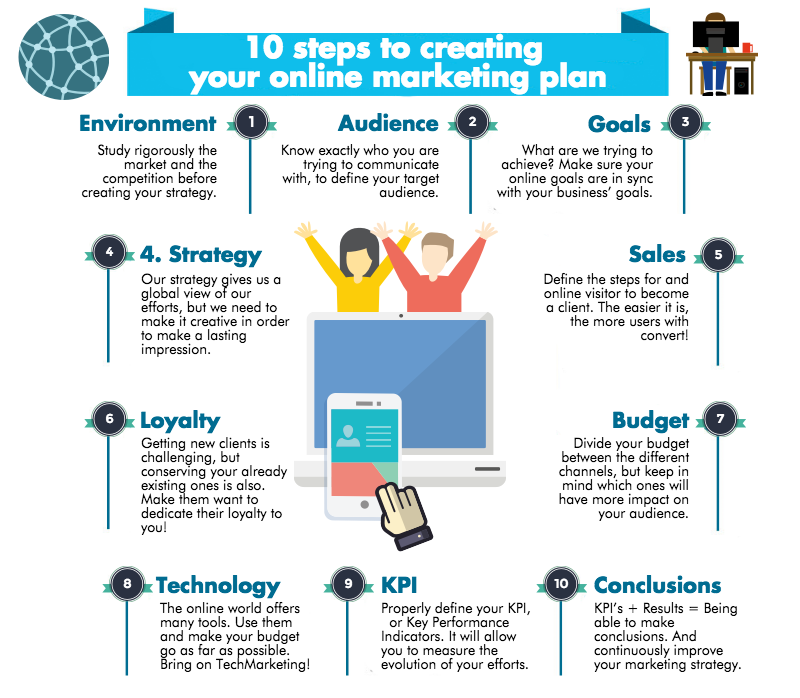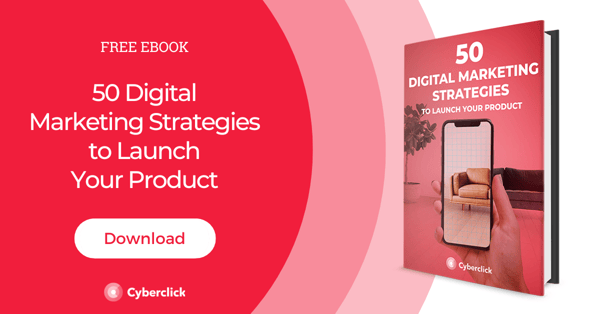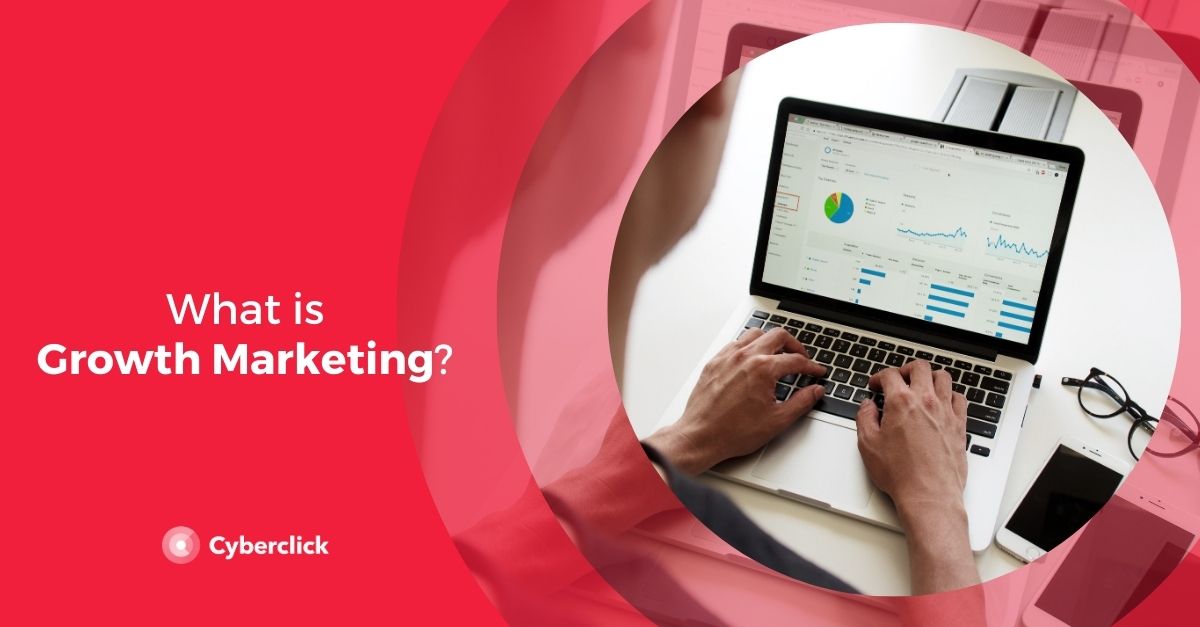Digital marketing tools are easily accessible and in many cases, even free of charge. However, before launching your brand online, you will need a “map” to help you know where you want to go to, how you will get there, and how to correct your path if needed. An online marketing plan will help you do all of these things.
An online marketing plan is essential to organizing your promotional efforts and making sure they correspond to your business’ goals. It's not about being on the internet “just for the sake of it” but about using all the tools online marketing offers in order to strengthen your brand and make the most of the benefits. So, are you ready to create your plan?
How to Create an Online Marketing Plan
1. Your Environment: The Market and the Competition
The first step to a good digital marketing strategy is understanding the environment you are working in. In order to do this, you need to study the market, your competition, the sector’s characteristics and trends, and the strengths weaknesses, opportunities, and threats. Finally, you'll need to find your USP or unique selling proposition: what makes your product stand out? What places it in a unique position in relation to the competition?
2. Your Audience
Marketing tools come bearing endless possibilities of audience segmentation, but to make the most of them it is vital to know who you are targeting, so the next step is to clarify this.
Demographics are an essential first step to defining your audience, but they aren't enough. You need to understand what your buyer's needs and motivations are and how to choose the best online channels and communication strategies to reach them. To do this, you can use you can use a variety of different tools.
3. Your Goals
Once you have completed the previous steps, you have to determine what exactly you are trying to achieve. Your online goals should be compatible with your overall business strategy. But to get started, a few possible goals may be generating clients for your new product or service, increasing customer loyalty by a certain percentage, increasing the number of times your product is mentioned favorably online, or growing traffic to your online store by a certain percentage.
When determining your plan’s goals, it can be useful to keep the SMART acronym in mind, as your goals should be:
- Specific
- Measurable
- Achievable
- Realistic
- Time-bound
4. Strategy and Creativity
Now we come to the core of your plan: strategy and creativity.
Your marketing strategy gives you a global vision of the actions you will take to establish to connect with your clients. It will help you achieve the goals you defined in the previous steps. To lay out your strategy, it is useful to divide your actions according to the conversion funnel. Logically, talking to someone who has never heard of your brand is not the same as talking to a regular customer.
Once you define your strategy, it's time to incorporate creativity, to make your message go further and leave a lasting impression.
5. The Sales Process
Based on the strategy you have defined, you will now need to determine your digital sales process. If you are looking to drive online sales, it is quite sensible to define a series of steps a user will go through on your website before they become a client. If your business is not an ecommerce, you'll need to find other ways to link your sales to your online communication efforts. This could be through lead generation, for example.
6. Loyalty
Once you have converted a user into a client, you are faced with one of the most interesting parts of online marketing: customer loyalty. It's significantly more challenging to get a new client than it is to keep an existing one, so this part of the plan is crucial.
Don’t forget to make the most of potential of cookies to get to know the habits and interests of your clients, and offer them what they need most, at precisely the right time.
7. The Budget
It’s time to talk about money. How do you define the budget of your online communication efforts? The most common method is dividing your investment between the different channels you are using (web, search engines, social media, etc.). To get it right, you need to be able to predict which channels and platforms will have greatest impact on our audience.
8. Technology
When it comes to technology, the online world offers endless possibilities that are constantly changing and evolving. So, how do you choose the best tools to implement our digital marketing plan? While there is no correct answer, if you have a clear idea of your budget, the expected return on investment, and the places your audience likes to spend time online, you'll be able to create an estimate. Don’t hesitate to ask for guidance from an expert who can explain in depth the pros and cons of different options.
9. The KPIs
Your plan is almost ready but you cannot forget an essential part: analyzing your results.
To define the success, you should define several KPIs or “Key Performance Indicators” that you will keep track of. These are metrics that show the results of your marketing efforts. An example of a KPI could be the acquisition cost of a new client of your e-commerce.
10. Measure and Adjust Accordingly
You now have your online marketing plan ready to go, but the job is not totally done. It is vital to establish periodic control tests of your KPIs and analyze your results to be sure that your marketing efforts are paying off. If they are not, you'll need to adapt your plan based on what isn't working. If they are, you can build on your existing plan and find new ways continuously improve.
Making an Agile Online Marketing Plan
In the early days of digital marketing, it was not uncommon to develop plans for one, two or even three years. However, this is obviously no longer feasible. This type of planning came from the much more static traditional marketing channels but the reality of online marketing today is very different. Things change quickly and we need to be ready to adapt, so let's look at a few ways to stay agile.
1. Data
We have more data than ever thanks to tools like Google Analytics and social media statistics. we can know what is happening with our campaigns and on our platforms at all times and in real time. Make the most of this data and use it to inform your strategies.
2. Online Marketing Is Constantly Changing
What was happening three years ago has little to do with the reality today. Consider for instance Google's changes or the updates to social networks, such as the inclusion of sponsored Instagram videos. It's crucial to stay up to date with these changes to maximize your SEO and stay relevant.
3. User Preferences Change Regularly
If you want to communicate effectively with your potential customers you need to know exactly where and how they spend their time online. What platforms do they prefer? Do they prefer to watch videos or look at images?
While you need to keep up with changes, it's also important not be carried away by improvisation. Use your marketing plan to define the overall objectives of your brand and review the results and trends monthly or even weekly to correct the course if needed and decide the next steps. However, don't jump on the bandwagon of any and every new trend or new platform. Make sure it fits in with your brand and that your users have adopted it. Only then can you ensure that your brand will succeed in the changing but exciting world of online marketing.
4. New Trends in Technology
Not only is it important to stay up to date on market trends and consumer preferences but it's also crucial to stay informed about new technological developments. Being aware of the latest tools and platforms will help you determine which of them can be integrated into your marketing strategy to boost your results. Technology plays a major role in consumer behavior so marketers need to be able to adapt swiftly and capitalize on new tools and opportunities.
CEO y cofundador de Cyberclick. Cuenta con más de 25 años de experiencia en el mundo online. Es ingeniero y cursó un programa de Entrepreneurship en MIT, Massachusetts Institute of Technology. En 2012 fue nombrado uno de los 20 emprendedores más influyentes en España, menores de 40 años, según la Global Entrepreneurship Week 2012 e IESE. Autor de "La empresa más feliz del mundo" y "Diario de un Millennial".
CEO and co-founder of Cyberclick. David Tomas has more than 25 years of experience in the online world. He is an engineer and completed an Entrepreneurship program at MIT, Massachusetts Institute of Technology. In 2012 he was named one of the 20 most influential entrepreneurs in Spain, under the age of 40, according to Global Entrepreneurship Week 2012 and IESE. Author of "The Happiest Company in the World" and "Diary of a Millennial".







Leave your comment and join the conversation